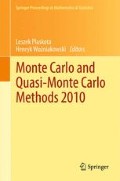Abstract
We show how to improve the performance of the quasi-Monte Carlo method for solving some pricing problems from financial engineering. The key point of the new algorithm, coined “GELT”, is an adaptive re-ordering of the point set so that the function is sampled more frequently in the regions where there is greater variation. The adaptivity only operates on the first few dimensions of the integrand and we show how to explicitly obtain the points of a digital sequence falling into boxes into these first few dimensions. This is effective as the problem is first transformed into having “low truncation dimension”. In general it is assumed that finance problems have low effective dimension. In addition we make use of a so-called “sniffer function” to cope with the discontinuity in the integrand function. Numerical results with the new adaptive algorithm are presented for pricing a digital Asian option, an Asian option and an Asian option with an up-and-out barrier.
Access this chapter
Tax calculation will be finalised at checkout
Purchases are for personal use only
References
F. Black and M. Scholes. The pricing of options and corporate liabilities. Journal of Political Economy, 81(3):637–654, 1973.
R. E. Caflisch, W. Morokoff, and A. B. Owen. Valuation of mortgage backed securities using Brownian bridges to reduce effective dimension. J. Comput. Finance, 1(1):27–46, 1997.
R. Cools and A. Haegemans. Algorithm 824: CUBPACK: A package for automatic cubature; framework description. ACM Trans. Math. Software, 29(3):287–296, 2003.
R. Cools, F. Y. Kuo, and D. Nuyens. Constructing embedded lattice rules for multivariate integration. SIAM J. Sci. Comput., 28(6):2162–2188, 2006.
J. Dick and F. Pillichshammer. Digital Nets and Sequences: Discrepancy Theory and Quasi-Monte Carlo Integration. Cambridge University Press, 2010.
H. Faure. Discrépance de suites associées à un système de numération (en dimension s). Acta Arith., 41(4):337–351, 1982.
M. B. Giles, F. Y. Kuo, I. H. Sloan, and B. J. Waterhouse. Quasi-Monte Carlo for finance applications. ANZIAM Journal, 50:308–323, 2008.
P. Glasserman. Monte Carlo Methods in Financial Engineering, volume 53 of Stochastic Modelling and Applied Probability. Springer-Verlag, 2003.
L. Grünschloß, M. Raab, and A. Keller. Enumerating quasi-Monte Carlo point sequences in elementary intervals. In H. Woźniakowski and L. Plaskota, editors, Monte Carlo and Quasi-Monte Carlo Methods 2010. Springer-Verlag, 2012. ibid.
J. Imai and K. S. Tan. A general dimension reduction technique for derivative pricing. J. Comput. Finance, 10(2):129–155, 2006.
J. Imai and K. S. Tan. An accelerating quasi-Monte Carlo method for option pricing under the generalized hyperbolic Lévy process. SIAM J. Sci. Comput., 31(3):2282–2302, 2009.
A. Keller. Myths of computer graphics. In Niederreiter and Talay [17], pages 217–243.
P. L’Écuyer and C. Lemieux. Recent advances in randomized quasi-Monte Carlo methods. In M. Dror, P. L’Écuyer, and F. Szidarovszki, editors, Modeling Uncertainty: An Examination of Its Theory, Methods, and Applications, pages 419–474. Kluwer Academic, 2002.
P. G. Lepage. A new algorithm for adaptive multidimensional integration. J. Comput. Phys., 27(2):192–203, 1978.
R. C. Merton. Theory of rational option pricing. Bell Journal of Economics and Management Science, 4(1):141–183, 1973.
H. Niederreiter. Random Number Generation and Quasi-Monte Carlo Methods. Number 63 in Regional Conference Series in Applied Mathematics. SIAM, 1992.
H. Niederreiter and D. Talay, editors. Monte Carlo and Quasi-Monte Carlo Methods 2004. Springer-Verlag, 2006.
A. B. Owen. Necessity of low effective dimension. Technical report, Dept. of Statistics, Stanford University, 2002.
A. Papageorgiou. The Brownian bridge does not offer a consistent advantage in quasi-Monte Carlo integration. J. Complexity, 18(1):171–186, 2002.
W. H. Press and G. R. Farrar. Recursive stratified sampling for multidimensional Monte Carlo integration. Computers in Physics, 4(2):190–195, 1990.
R. Schürer. Adaptive quasi-Monte Carlo integration based on MISER and VEGAS. In H. Niederreiter, editor, Monte Carlo and Quasi-Monte Carlo Methods 2002, pages 393–406. Springer-Verlag, 2004.
R. Schürer and W. C. Schmid. MINT: A database for optimal net parameters. In Niederreiter and Talay [17], pages 457–469.
I. H. Sloan and H. Woźniakowski. When are quasi-Monte Carlo algorithms efficient for high dimensional integrals? J. Complexity, 14(1):1–33, 1998.
P. van Dooren and L. de Ridder. An adaptive algorithm for numerical integration over an n-dimensional cube. J. Comput. Appl. Math., 2(3):207–217, 1976.
X. Wang and I. H. Sloan. Why are high-dimensional finance problems often of low effective dimension? SIAM J. Sci. Comput., 27(1):159–183, 2005.
X. Wang and I. H. Sloan. Efficient weighted lattice rules with applications to finance. SIAM J. Sci. Comput., 28(2):728–750, 2006.
X. Wang and I. H. Sloan. Quasi-Monte Carlo methods in financial engineering: An equivalence principle and dimension reduction. Operations Res., 59(1):80–95, 2011.
Acknowledgements
The authors are grateful to Prof. Ian H. Sloan for useful discussions related to this paper and very much appreciated the careful comments and questions from the two anonymous referees. The first author is a fellow of the Research Foundation Flanders (FWO) and is grateful to the University of New South Wales where large parts of this paper were written; and therefore also thanks the Australian Research Council (ARC) for support.
Author information
Authors and Affiliations
Corresponding author
Editor information
Editors and Affiliations
Rights and permissions
Copyright information
© 2012 Springer-Verlag Berlin Heidelberg
About this paper
Cite this paper
Nuyens, D., Waterhouse, B.J. (2012). A Global Adaptive Quasi-Monte Carlo Algorithm for Functions of Low Truncation Dimension Applied to Problems from Finance. In: Plaskota, L., Woźniakowski, H. (eds) Monte Carlo and Quasi-Monte Carlo Methods 2010. Springer Proceedings in Mathematics & Statistics, vol 23. Springer, Berlin, Heidelberg. https://doi.org/10.1007/978-3-642-27440-4_34
Download citation
DOI: https://doi.org/10.1007/978-3-642-27440-4_34
Published:
Publisher Name: Springer, Berlin, Heidelberg
Print ISBN: 978-3-642-27439-8
Online ISBN: 978-3-642-27440-4
eBook Packages: Mathematics and StatisticsMathematics and Statistics (R0)

